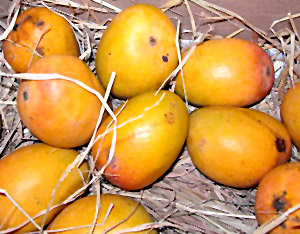 Mango is a thick drupe fruit with its outer fleshy part surrounding a pyrene of hard endocarp enclosing a seed inside. Mango belongs to the Mangifera genus, which belongs to the flowering plant family of Anacardiaceae. Mangoes are relished all over the world for their bright color and sweet juicy flesh. Mango is basically an Indian native fruit and was eventually spread through out the world. Indian mango or Mangifera indica is mostly cultivated in various tropical and subtropical regions. Mango, derived from the Tamil word Mangai or Mankay, as well as the Malayalam word Manna, is the national fruit of India. More than 100 varieties of mangoes are found in India, in various shapes, sizes and colours. In India, Mango fruit and leaves are sometimes used in various rituals and religious events. Mango is also used to make pickles or chutneys and the fruit contains antioxidant vitamins A, C, and D.
Mango is a thick drupe fruit with its outer fleshy part surrounding a pyrene of hard endocarp enclosing a seed inside. Mango belongs to the Mangifera genus, which belongs to the flowering plant family of Anacardiaceae. Mangoes are relished all over the world for their bright color and sweet juicy flesh. Mango is basically an Indian native fruit and was eventually spread through out the world. Indian mango or Mangifera indica is mostly cultivated in various tropical and subtropical regions. Mango, derived from the Tamil word Mangai or Mankay, as well as the Malayalam word Manna, is the national fruit of India. More than 100 varieties of mangoes are found in India, in various shapes, sizes and colours. In India, Mango fruit and leaves are sometimes used in various rituals and religious events. Mango is also used to make pickles or chutneys and the fruit contains antioxidant vitamins A, C, and D.
History related to Mango
There is adequate mention of mango in Indian history. Kalidasa, the renowned Indian poet, has praised the fruit in his lyrics. The Chinese traveler Hieun Tsang, as well as Alexander the great have also savoured and praised mango, during their conquests to the country. Mughal emperor Akbar is also believed to have planted almost 100,000 mango trees in Darbhanga (now Bihar).
Features of Mango
The Mango fruit requires almost 6 to 8 weeks to ripen and the seed is usually contains fibres. The ripe Mango fruit is available in various shapes, sizes and colours. Cultivars can be yellow, orange, red or green, and contains a flat oblong hairy or fibrous pit on the surface, which is strongly bound with the flesh or pulp of the fruit. The pit contains a thin lining covering a single seed, 4-7 mm in length, which has the plant embryo.
Cultivation of Mango
Mango is mostly cultivated in tropical and subtropical climates in India. India stands in the 2nd position in mango production, after China. Around a 3rd of world`s total mangoes are cultivated in India only. But the country consumes most of its produce and contributes only 1% to the international mango trade. Mango is abundantly cultivated in other parts of the world as well like Bangladesh, Pakistan, Australia, Southeast Asia, Africa, Caribbean and America.
Cuisines of Mango
Mango is widely used in Indian cuisine. Unripe mango is utilised in the preparation of Chutneys or side dishes and may also be consumed raw, mixed with spices. The green unripe mango is also used as a cooling drink called "Aam Panna", which is most popular in summer months. Ripe Mango is also used in various drinks such as Mango Lassi. "Aam-Ras" is also made with ripe mango as well. Mango is also used in making preserves, such as Amchur and Moramba, and curries. Moreover Mango is also utilised fro preparing smoothies, ice cream, juices and fruit bars.
Cultural significance of Mango
Mango is the national fruit of India. According to Hindu beliefs, properly ripe mango is considered as a symbol of accomplishment and is often depicted being held by Lord Ganesha. Goddess Saraswati is worshipped with Mango blossoms as well. Moreover, leaves of Mango tree is also used to adorn entrance or doorways, particularly during auspicious events and ceremonies. Paisleys and motifs of Mango are also used in Indian embroidery, and are mostly seen in Kanchipuram silk sarees, shawls of Kashmir etc.











